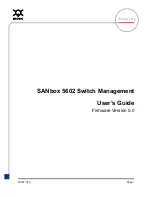
4-6
Troubleshooting
Diagnosing with the LEDs
T
rou
bl
esh
oot
in
g
D
A fault condition
has been detected
on the power
supply installed in
the slot
corresponding to
the flashing
number.
Because the Power LED is on, the switch is receiving power from one power supply,
but the power supply in the slot corresponding to the flashing number may be
unplugged from an active AC power source, or may be faulty.
• Verify the power cord for the power supply whose number is flashing is plugged
into an active power source and to the switch. Ensure these connections are
snug.
• Disconnect the AC power cord from the power supply in the slot corresponding
to the flashing number, then try removing and reinstalling the power supply.
Caution:
Ensure the AC power cord is disconnected from the supply before removing
and reinstalling the supply.
Reconnect the power supply to the AC power source. If the error indication reoccurs
after the supply is reinstalled, the power supply may be faulty. Call your HP-
authorized LAN dealer, or use the electronic support services from HP to get
assistance. See the Customer Support/Warranty card for more information.
E
The switch has
experienced a
backplane failure
during self test.
The failure may be just in the communications with a single module slot, or it might
be more significant. Start a console session with the switch, and at the CLI prompt
issue the command
show logging
. In the event log that is displayed, there will be
messages that describe the extent of the problem. If the problem is with individual
slots, the remainder of the switch slots will be fully operational and can be used until
you get a chance to replace the switch.
If necessary to resolve the problem, contact your HP-authorized LAN dealer, or use
the electronic support services from HP to get assistance. See the Customer
Support/Warranty card for more information.
F
The network port
for which the Link
LED is flashing has
experienced a self
test or initialization
failure.
When the switch is powered on, each network port is tested. If the port self test fails,
the individual port is not usable, but the rest of the ports on the chassis, which have
passed their self test, will continue to operate normally.
To verify the port has failed, try power-cycling the switch. If the port fault indication
reoccurs, and the port is one of the fixed ports on the chassis, you will have to
replace the switch. In the meantime, all the other fixed ports on the chassis will
operate normally.
G
The module
installed in the slot
that corresponds to
the letter that is
flashing has
experienced a self
test or initialization
fault.
The modules are all tested whenever the switch is powered on, or reset (through
the Reset button on the switch, or the Reboot or Reset options in the console or web
browser interface), and when they are hot swapped (installed when the switch is
powered on).
Try removing and reinstalling the module. You can do this without having to power
down the switch. When the module is reinstalled, it will be retested automatically.
If the fault indication reoccurs, the module may have failed. Remove the module from
the switch and replace it with another module, or install a slot cover plate. Call your
ProCurve authorized LAN dealer, or use the electronic support services from
ProCurve to get assistance. See the Customer Support/Warranty card for more
information.
Tip
Letter
Problem
Solution
















































